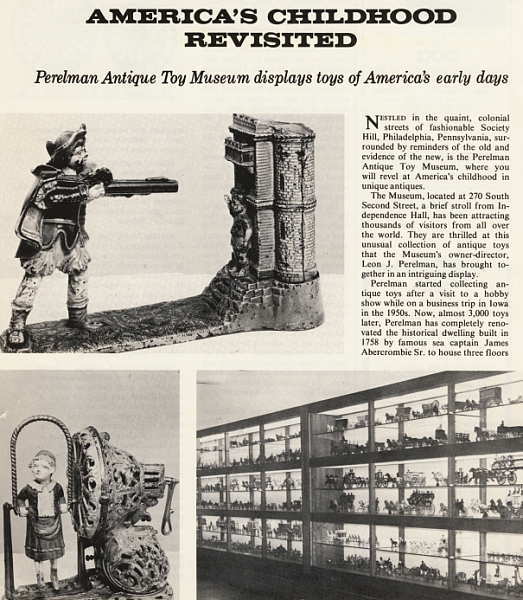HOLIDAY INN
INTERNATIONAL MAGAZINE, 1970's, pages 61 & 62
AMERICA'S CHILDHOOD
REVISITED
Perelman Antique Toy Museum displays toys of America's early days Nestled in the quaint, colonial streets of fashionable Society Hill, Philadelphia, Pennsylvania, surrounded by remainders of the old and evidence of the new, is the Perelman Antique Toy Museum, where you will revel at America's childhood in unique antiques. The Museum, located at 270 South Second Street, a brief stroll from Independence Hall, has been attracting thousands of visitors from all over the world. They are thrilled at this unusual collection of antique toys that the Museum's owner-director, Leon J. Perelman, has brought together in an intriguing display. Perelman started collecting antique toys after a visit to a hobby show while on a business trip in Iowa in the 1950s. Now, almost 3,000 toys later, Perelman has completely renovated the historical dwelling built in 1758 by famous sea captain James Abercrombie Sr. to house three floors of systematically arranged antique toys. Included in this display are mechanical, animated and still toys and banks of cast iron or tin, covering the period from the end of the Civil War to the beginning of World War I. The toys, all operative, represent what children in past generations played with and enjoyed. Among the many fascinating and unusual items in the collection are the mechanical banks. Each bank, mostly constructed of cast iron, performs a unique mechanical action or stunt. Mechanical banks provided a pleasant way of saving money for the children of yesteryear. The coin receptacles, master pieces of craftsmanship with eye-catching movable parts, touched off the child's curiosity and lured them into the habit of saving. Not only did these banks appeal to children, but also to the parents, who purchased them in large quantities. A penny inserted into the slot of many of these toy banks produced a very amusing and sometimes noisy result. The banks depict folklore, such as the William Tell Bank with a cap that explodes nosily when William Tell fires a penny at an apple on his son's head, and the Jonah and the Whale Bank has Jonah sitting in a little boat feeding a coin (instead of himself) to the whale. The Uncle Sam Bank, patented in 1886, nods his head as if to say "thank you" when the coin placed in his outstretched hand slips into his carpetbag. A coin placed in the trunk of a P. T. Barnum jumbo elephant is sent hurtling into the air where it drops into a slot on the animal's back. A magician makes a coin disappear by raising and lowering his hat on the coin. In every sense, the mechanical bank is truly unusual and peculiar American phenomenon. In addition to the toy banks, the Perelman Museum displays a wide assortment of automatous toys. Each does what it represents by performing one or more mechanical functions. One such toy has U. S. Grant seated in a chair, smoking with satisfaction as he turns his head and puffs out smoke leisurely. A preacher at his pulpit realistically exhorts his flock, and a minstrel swings his musical clappers vigorously in his hands. A rare collection of animated cap pistols with fantastically shaped and decorated handles and figures of men or animals mounted on the barrel offer additional intrigue to the collection. Pull the trigger of one of these creations and barrel-mounted figures react so violently that their motion causes the cap to explode. Equally as scarce are the iron toys in the museum. Fire engines, hook-and ladders, stage coaches, hansom cabs, brakes, gigs and other types of vehicles including railroad cars, circus trains and boats of every description are exhibited. Antique dolls, just as interesting if not more original than today's modern counterparts, are a valuable part of the collection. There is a walking doll produced in 1868 in Washington, D. C., a Queen Anne doll dated 1740 and a doll made of hard rubber by Goodyear in 1851. A three-faced doll produced in France in 1893, capable of making three different facial expressions, is also on display along with many creations designed after historical people and events. Antique marbles, ranging from the size of a pea to a golf ball, a favorite pastime for boys dating as far back as the Roman and Egyptian empires, can be seen as well as optic toys from 1897 with graphic depictions of battles. A fine collection of games is displayed, including an early version of Old Maid, Snap and a game that was the forerunner of Monopoly. The first jigsaw puzzle, made in the late 1800s can be found here. The Museum is open daily to visitors for a nominal fee and is a must for all those visiting the City of Brotherly Love. The Perelman Antique Toy Museum offers a completely different nostalgic and educational experience: the history of America as seen through the delightful charm of antique toys . . . inviting you to stroll back into America's childhood. |
